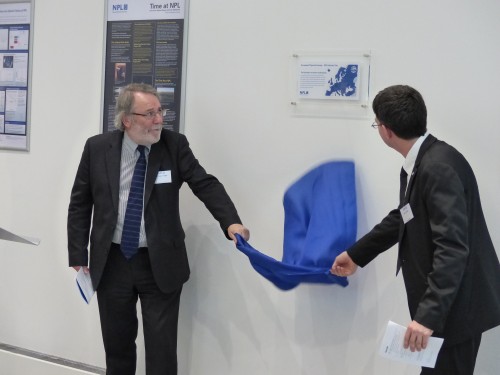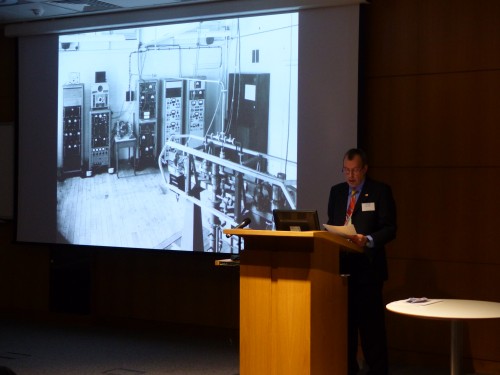
Peter Knight (left) and John Dudley unveiling the historic plaque.
By Hamish Johnston
On Friday I braved the torrential rains that have been soaking southern England to make the journey from Bristol to Teddington, which is the birthplace of the atomic clock. Situated in the leafy suburbs west of London on the swollen banks of the River Thames, Teddington is the home of the National Physical Laboratory (NPL), which is the UK’s standards and metrology lab.
It was at NPL in 1955 that physicist Louis Essen fired up the world’s first atomic clock and as a result the lab has just been made a Historic Site by the European Physical Society (EPS). Below you can see a close-up of the plaque that was unveiled at NPL at a ceremony on Friday.
Essen’s clock was based on a beam of caesium atoms and was monitored by microwave technology inspired by Essen’s wartime work on radar. The clock was nicknamed the “Flying Bedstead” by engineers at the BBC and on 3 June, 1955, the BBC time signal included input from Essen’s clock, making atomic time available worldwide for the first time.
The Flying Bedstead was more than a metre long and required banks of external electronics and vacuum pumps. However, two years later Essen and colleagues built a much smaller transportable atomic clock. Then, in 1967, the second was redefined as an SI unit based on an atomic transition in caesium, thereby ending the ancient practice of defining time though astronomical observations.

EPS Historic Site plaque at the National Physical Laboratory.
The plaque to Essen and the atomic clock was unveiled by John Dudley, president of the European Physical Society, and Peter Knight, who is a past president of the Institute of Physics and the Optical Society of America.
The ceremony was followed by talks by Ray Essen, Louis Essen’s son-in-law, and by the NPL’s Patrick Gill. After lunch I caught up with Gill and his colleague Helen Margolis to record a podcast about optical clocks, which look set to replace atomic clocks as international and national time standards. So stay tuned for much more about optical clocks here at physicsworld.com.

Ray Essen shows a photograph of the Flying Bedstead.
When I was at NPL, the lab was preparing for its annual open house, which will be on 20 May. I attended an open house several years ago and it was a great day out. Visitors can wander into selected labs, marvel at the scientific equipment and best of all, have a good long chat with the researchers. So if you ever wondered what an atomic clock looks like, make your way to Teddington in May. More details can be found here and you must register first.
Trackback: Blog - physicsworld.com